 Case Report
Case Report
The Role of Orthodontics in Gap Closure with Dental Implants
Dr Clemens Fricke1* and Dr Marc Hansen2
1Orthodontic specialist, Saarlandstrasse 80-82, 44139 Dortmund, Germany
2Hansen Dentist and specialist in oral surgery, Schuuferstrasse 206, 44269 Dortmund, Germany
Dr Clemens Fricke, Orthodontic specialist, Saarlandstrasse 80-82, 44139 Dortmund, Germany.
Received Date:November 30, 2022; Published Date: December 14, 2022
Case Report
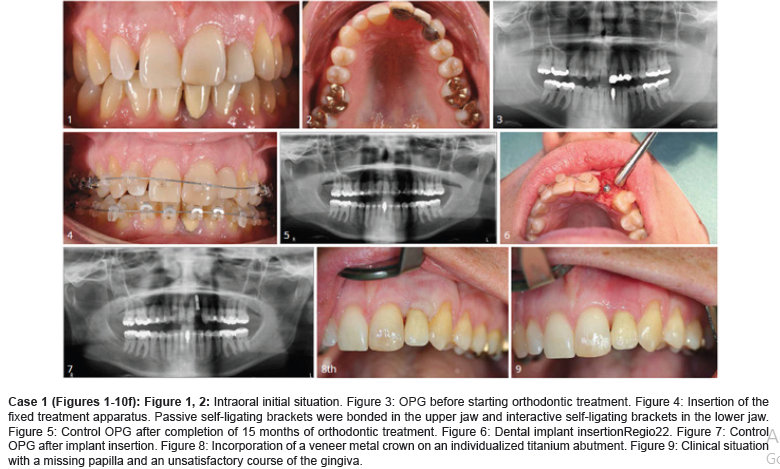
If missing teeth are to be replaced by a prosthetic restoration, teamwork from several dental disciplines is required in most cases. Pre-prosthetic orthodontic treatment is often necessary first in order to create the conditions for an aesthetically pleasing denture. Especially the gap management for the set zen dental implants play an important role here.
For many indications, orthodontics requires close cooperation with numerous specialist disciplines, also outside of dentistry. For example, cooperation with orthopedists and physiotherapists is essential in diagnosing and treating craniomandibular dysfunction (CMD).
Close points of contact with specialized areas of dentistry often arise in the case of planned prosthetic fittings, e.g. B. by means of implants. Orthodontic treatment measures are often required as a first step in order to enable the implant to be placed. This will be shown below using two case studies.
Case Study 1 (Figures 1-10)
The 40-year-old patient presented to the implantology practice and expressed the desire to replace an existing Maryland bridge in the anterior region with an implant. The bridge made many years ago in another dental practice kept coming loose. In addition, due to the additional layers of adhesive that were applied without removing the old plastic residues, teeth 21 and 23 were displaced labially (Figures 1 and 2). The problem of the converging teeth 21 and 23 was clearly evident on the orthopantomogram newly prepared in the implantology practice (Figure 3). Even if a narrow implant had been used, endosseous implantation would not have been possible here. The patient was therefore referred to an orthodontic practice for consultation.
After removing the adhesive bridge, a passive self-ligating bracket appliance was placed in the upper jaw and an interactive self-ligating bracket appliance in the lower jaw, with ceramic brackets being used in the upper and lower anterior region for aesthetic reasons-Damon®Clear (Ormco) in the OK (33, except 22) as well as InOvation®C (Dentsply GAC) in the UK (55). The aim of the orthodontic treatment in the upper jaw was to achieve a correct tooth position in the labial-palatine direction by means of optimal tip and torque values and to straighten the roots of teeth 21 and 23. In the lower jaw it was necessary to correct the existing slight crowding.
Thanks to the low-force and low-friction treatment philosophy of the passive self-ligating bracket system used, the root situation 21 and 23 for the planned implant could be optimally corrected within a very short time (Figure 4). After a total treatment time of almost 15 months, a control OPG was made, on which the correct root position was finally recognizable (Figure 5). This meant that a diameterreduced, two-part implant could then be placed in region 22 (Figures 6 and 7).
If the healing process was uneventful, a VMK crown was integrated on an individualized titanium abutment after the healing phase of the implant (Figure 8). The initially unsatisfactory course of the gingiva and the missing papilla (Figure 9) were not surgically corrected, since the papilla would predictably form again if the contact point to the neighboring tooth was designed correctly and the crown was anatomically clean. After four weeks, the soft showed tissue was further optimized and after three months healed perfectly without any further measures (Figure 10a). The final check in the orthodontic practice showed further results in addition to the straightened and straightened tooth axes of teeth 21 and 23: The symmetry was optimized, the head/crossbite tendency was transferred to the right and the smile line was converted into a positive one. The harmonious width ratio of the front teeth in the sense of the “golden ratio” could be achieved. Furthermore, there was a consistent red and white aesthetics and a physiological representation of the papillae (Figures 10b-f).
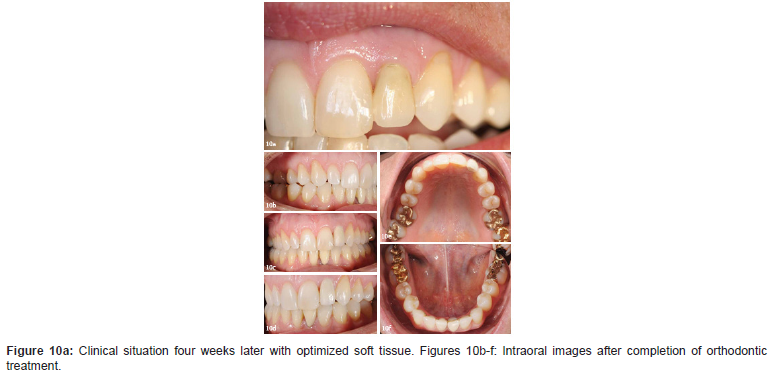
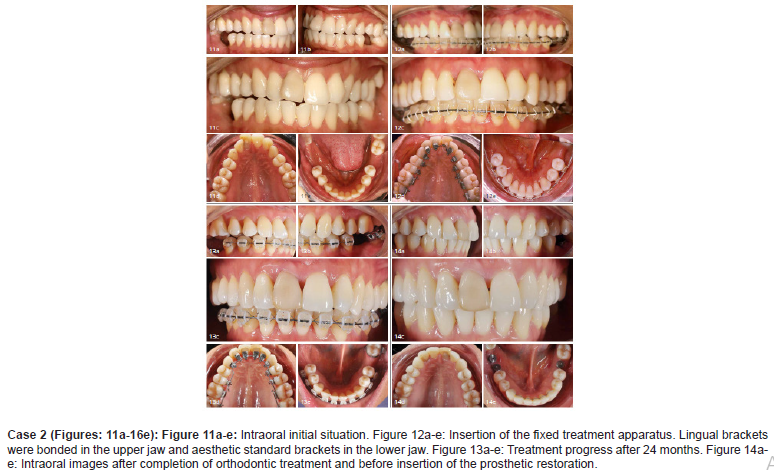
Case Study 2 (Figures 11-16)
In the implantology practice, the 28-year-old patient expressed the desire for a fixed denture in the lower jaw (teeth 36, 46, 47) and for correction of the misalignments in both arches in the the corresponding orthodontic diagnostics showed that the patient had a mandibular center shift to the right-without a forced bite and free of any CMD symptoms. Furthermore, the occlusal plane was inclined to the top right. The bite was in the right side tendon area open; in the anterior as well as in the left posterior segment almost all teeth were head bite (Figures 11a-e).
The patient had high demands in terms of aesthetics and function, so an orthodontic treatment that was as inconspicuous as possible and efficient at the same time was chosen.
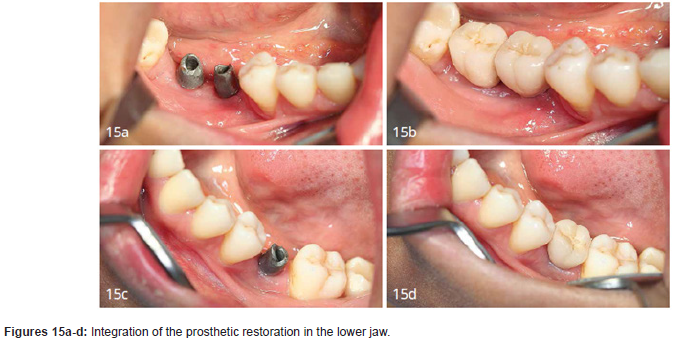
The upper jaw was treated with an individualized lingual appliance (Ormco company). Due to the large gaps in the lower jaw and the preprosthetic objectives, the decision was made in favor of buccal ceramic brackets (Clarity TM, 3M Unitek) (Figures 12a-e). At the follow-up appointment 24 months later (Figures 13a-e), the treatment progressed so well that the insertion of the dental implants in the lower jaw could be planned and carried out accordingly. After the implantation, healing phase and exposure (Figures 14a-e) was finally integrated into the prosthetic fitting (Figures 15a-d).
The final check in the orthodontic practice showed secure static and dynamic occlusion, well-formed dental arches and stable periodontal conditions. The open bite on the right side could be closed and the tooth axes and the occlusal plane corrected. The head bite situation had been resolved and transferred to physiological conditions. The neutral arch of laughter was optimized into a positive arch of laughter (Figures 16a-e).
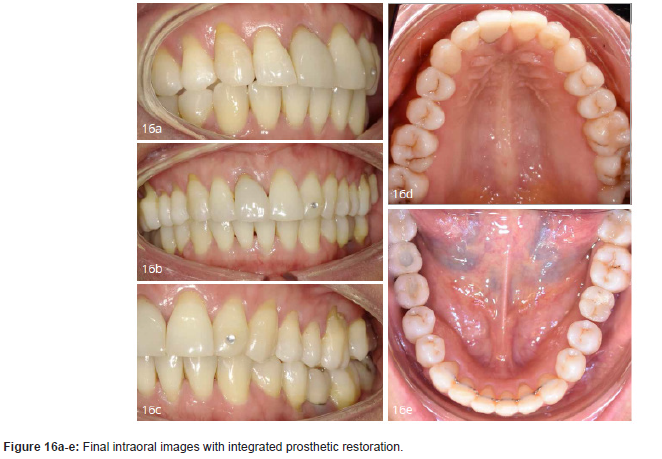
Conclusion
The two patient examples shown make it clear how important close cooperation between implantology and orthodontics is when planning an implantation. Depending on the indication, prior orthodontic treatment is often essential in order to be able to meet the patient’s desire for a denture that meets the highest aesthetic and functional requirements. If case discussions and planning take place in the network of experts, optimal care for the patient is possible, which results in an extremely high level of satisfaction and, last but not least, a regional reputation.
Acknowledgement
None.
Conflict of Interest
No conflict of interest.
-
Dr Clemens Fricke* and Dr Marc Hansen. The Role of Orthodontics in Gap Closure with Dental Implants. On J Dent & Oral Health. 6(4): 2022. OJDOH.MS.ID.000641
-
: Orthodontics, Dental implants, Implant dentistry, Prosthetic restoration, Dental disciplines, Pre-prosthetic orthodontic treatment, Upper jaw, Craniomandibular dysfunction, Lower jaw, Teeth.
-

This work is licensed under a Creative Commons Attribution-NonCommercial 4.0 International License.






